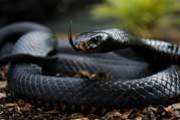We see them in books, on TV and our pet stores are full of 'em. But that doesn't mean that reptiles can't be endangered. There are Snakes, lizards, turtles and crocodiles around the world facing the possibility of extinction due to habitat loss, pollution and human greed. Take a look at these fierce but fragile endangered reptiles that Kidzworld wants to bring to your attention.
Endangered Reptiles - San Francisco Garter Snake
The San Francisco Garter Snake is a relative of the common garter snake that is found all over North America. The San Francisco Garter Snake differs from the common version mainly in its coloring. This snake is characterized by an orange-ish head, black and red striping/blotching on its back and a blue or blue/green belly. Its beauty is one reason that has led to its endangered status. Reptile collectors have been known to pluck this rare snake from its habitat to sell on the black market. The other reason numbers of the San Francisco Gartner Snake have dropped to between 1,000 to 2,000 is habitat destruction. Urbanization and pollution are the main culprits.
Endangered Reptiles - Green Sea Turtle
While all green sea turtles are threatened, it is the population off the coasts of Florida and Mexico that are closest to extinction. Because they live in the sea, it is hard to know exact population numbers. All we can do is count how many breeding females come to shore each year to lay their eggs. At last count, there were between 200 and 1,100 breeding green sea turtle females. Other places in the world such as India and Australia see thousands of nesting females each year, but their numbers are also declining. Green sea turtles have been commercially harvested for eggs and food. Other turtle parts are used for leather and jewelry. It takes a female green sea turtle 20 to 50 years to begin reproducing. If commercial harvesting of the turtles and their eggs does not stop, their numbers will continue to drop.
Endangered Reptiles - Komodo Dragon
The Komodo Dragon, the world's largest lizard, is only found in one place today - Komodo National Park, a small group of islands off the coast of Indonesia. Today there are between three and six thousand Komodo Dragons, but it is estimated that only 350 of them are females. Whether this will impact the Komodo Dragon's ability to maintain stable numbers is unkown. Things that do threaten the Komodo Dragon are natural disasters like volcanic erruptions and forest fires, as well as human destruction of their habitat. This 10-ft (3-m) reptile became the inspiration for the very first Godzilla movie when one was brought to New York in 1920.
Endangered Reptiles - Tuatara
The tuatara is a lizard-looking reptile that is believed to be one of the oldest species on Earth, having barely changed in the past 220 million years. There are two different tuatara species, the common tuatara, found on a few different New Zealand islands and the Brother's Island tuatara, found only on Brother's Island off the coast of New Zealand in the Cook Strait. The Brother's Island tuatara population is less than 300. Tuatara's have been classified as an endangered species since 1895, but still face the threat of extinction due to habitat loss and the introduction of predators like rats, weasels and badgers.
Endangered Reptiles - Gharial
The gharial is a crocodile-like reptile with a long, narrow snout and numerous sharp teeth. It is only found in the rivers of India, and a few surrounding areas like Bangladesh and Pakistan. Gharials live entirely on fish due to their slender snouts, which are incapable of catching larger prey. Its name came from the Indian word ghara, which is a pot that resembles the gharial's long snout. Even though the gharial has been listed as an endangered species and has been protected since 1973, there are only about 1,500 gharials in the wild today. Conservation programs have been in effect for the past twenty years and continue to take place to ensure the gharial's survival.
- Do you know of any more endangered reptiles? Do you have any ideas on how we can help protect these endangered species? and let us know what you think!

































